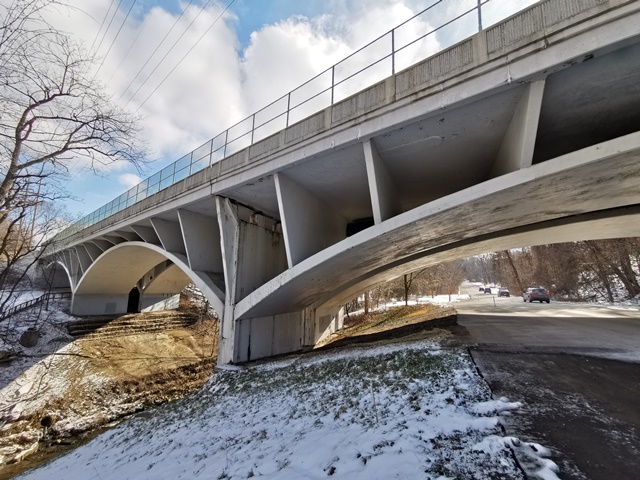We Recommend:
Bach Steel - Experts at historic truss bridge restoration.
BridgeHunter.com Phase 1 is released to the public! - Visit Now
Monticello Boulevard Bridge
Wilson Mills Road Bridge

Primary Photographer(s): Nathan Holth
Bridge Documented: February 1, 2023
Monticello Boulevard (Wilson Mills Road) Over West Branch Euclid Creek
South Euclid: Cuyahoga County, Ohio: United States
1954 By Builder/Contractor: Unknown and Engineer/Design: Osborne Engineering Company of Cleveland, Ohio
2003
140.0 Feet (42.7 Meters)
368.0 Feet (112.2 Meters)
62 Feet (18.9 Meters)
3 Main Span(s)
1830082

View Information About HSR Ratings
Bridge Documentation
This unique and striking concrete arch bridge is noted for its rare European design inspired by famous engineer Robert Maillart.
View Archived National Bridge Inventory Report - Has Additional Details and Evaluation
Information and Findings From Ohio's Historic Bridge InventorySetting/Context The bridge carries a 4-lane city street and sidewalks over a stream and park drive in the Euclid Creek Reservation in Cleveland. Physical Description The skewed, 362'-long, three span, ribbed open spandrel arch bridge has span lengths of 108', 140', and 108'. Very much in the attenuated artistic and design style of noted Swiss engineer Robert Maillart and his deck-stiffened arches, the bridge is reduced to its most basic with no applied ornamentation. The main span, a three-center arch, has a small rise of 18'-8" over its 140' length. The approach spans are segmental with the springing at the interior and crown at the ends. The abutments are well designed with buried buttresses to resist the arch thrust. The plain spandrel walls extend beyond the plane of the ribs to support the cantilevered deck sections. Since the distance between the walls varies, the slopes of the walls differ to create an uncommon visual effect. The bridge is finished with plain metal railings. Summary of Significance The 1954-55 ribbed open spandrel arch bridge is a rare and successful American example of the attenuated, deck-stiffened arch bridge design and aesthetic developed by noted Swiss engineer Robert Maillart. Noted for its extremely thin arch ribs and spandrel supports, Maillart's severe designs reduced the open spandrel arch to its most basic where the steel is literally just covered in concrete. Maillart's sleek, deck-stiffened arch bridges were not built in great numbers. Carl Condit, in his seminal American Building Art Nineteenth Century attributes American's need for capacity to carry significantly heavier loads than the Europeans as a prime reason for the scarcity of the sophisticated design in this country. The Monticello Road bridge was designed by Osborn Engineering of Cleveland, and the bridge type and design were selected because of the setting in the Euclid Creek Reservation and the insistence of William Stinchcomb of the Metropolitan Park Board. The Monticello Road bridge marks a strong departure from the commonly used design for open spandrel arch bridges in the state and region. It has high artistic merit (criterion C) and technological influence of Robert Maillart, one of the most important bridge and influential designers of the 20th century. Research by William Vermes and Dario Gasparini suggests that Ralph Scott with Osborn Engineering was responsible for the conceptual design of the bridge. Scott joined the firm after World War II, and he became president of the company in 1974. The county's plans for the bridge are filed as Drwg. No. B-104. Justification The bridge stands as the finest post-World War II example of its type in the state. It is also one of the finest reinforced concrete bridges of any type built after the war. Bridge Considered Historic By Survey: Yes |
![]()
Photo Galleries and Videos: Monticello Boulevard Bridge
Unorganized Photos
Original / Full Size PhotosA collection of overview and detail photos, presented as an unorganized and unlabeled collage and gallery. This gallery offers photos in the highest available resolution and file size in a touch-friendly popup viewer.
Alternatively, Browse Without Using Viewer
![]()
Unorganized Photos
Mobile Optimized PhotosA collection of overview and detail photos, presented as an unorganized and unlabeled collage and gallery. This gallery features data-friendly, fast-loading photos in a touch-friendly popup viewer.
Alternatively, Browse Without Using Viewer
![]()
Maps and Links: Monticello Boulevard Bridge
Coordinates (Latitude, Longitude):
Search For Additional Bridge Listings:
Bridgehunter.com: View listed bridges within 0.5 miles (0.8 kilometers) of this bridge.
Bridgehunter.com: View listed bridges within 10 miles (16 kilometers) of this bridge.
Additional Maps:
Google Streetview (If Available)
GeoHack (Additional Links and Coordinates)
Apple Maps (Via DuckDuckGo Search)
Apple Maps (Apple devices only)
Android: Open Location In Your Map or GPS App
Flickr Gallery (Find Nearby Photos)
Wikimedia Commons (Find Nearby Photos)
Directions Via Sygic For Android
Directions Via Sygic For iOS and Android Dolphin Browser
USGS National Map (United States Only)
Historical USGS Topo Maps (United States Only)
Historic Aerials (United States Only)
CalTopo Maps (United States Only)

